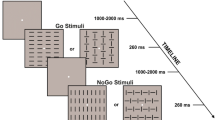Abstract.
In previous EEG experiments we have presented a time estimation task to our subjects, who had to press a button with either the left or right index finger 3 s after an auditory warning stimulus (WS). Two seconds later a visual Knowledge of Results (KR) stimulus was presented on a screen in front, informing them about whether the movement had been made in the correct time window (a vertical line), whether it was too early (a minus sign) or too late (a plus sign). The potential distribution underlying the anticipatory attention for the KR stimulus suggested a right hemisphere network in which the prefrontal cortex, the insula Reili and the parietal cortex were involved. In the present positron emission tomography (PET) activation study we aimed to further localize the exact positions of these regions, using the same paradigm. Two conditions were compared in which the WS had to be followed by a button press with the left index finger. In experimental condition A, subjects received true information about their performance, while in condition B false information was given, utilizing the same stimuli, but randomly, thus without any relation to the actual performance. In both conditions identical stimuli were presented and identical movements were made. Therefore we applied statistical parameter mapping (SPM) for comparison of condition A with B in order to identify regional increases in perfusion related to the anticipation and use of the KR. We found in line with our predictions a right hemisphere activation of (1) BA45, (2) the junction of the posterior insula with the temporal transverse gyrus and (3) the posterior part of the parietal cortex. This activation pattern was accompanied by a better performance due to KR. A second, though not predicted, effect was the increase in correct responses during the last two sessions compared to the first two sessions, independent of KR. This learning effect was accompanied by an activation of BA46 and the supplementary motor area (SMA), again in the right hemisphere. Summarizing, two different prefrontal areas in the right hemisphere were activated: a more ventral area, related to the use of external stimuli providing feedback about a past performance, in order to produce movements in time, and another mid-dorsal one, related to temporal programming on the basis of internal cues.
Similar content being viewed by others
Author information
Authors and Affiliations
Additional information
Electronic Publication
Rights and permissions
About this article
Cite this article
Brunia, C., de Jong, B., van den Berg-Lenssen, M. et al. Visual feedback about time estimation is related to a right hemisphere activation measured by PET. Exp Brain Res 130, 328–337 (2000). https://doi.org/10.1007/s002219900293
Received:
Accepted:
Published:
Issue Date:
DOI: https://doi.org/10.1007/s002219900293




